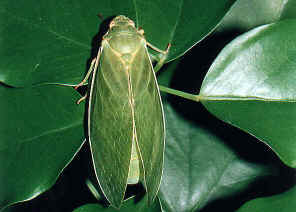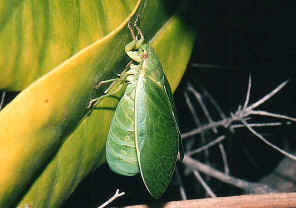|
| |
Family Cicadidae
- This page contains pictures and information about Bladder Cicadas that we found in
the Brisbane area, Queensland, Australia.
-
 - Male, body length 50mm, singing at night
-
- Bladder Cicadas are large in size. However, they are not easily noticed
because of their good camouflage and only active at night. Their forewings are in leaf shape, opaque and
green in colour. Their bodies and heads are also green with yellow-brown
compound eyes. The male Bladder Cicadas have the greatly enlarged abdomen,
largely hollow. This is the resonating chamber to amplify the loudness of their
songs. Females are smaller in size and relatively smaller abdomen.
   -
- We first found this Bladder Cicada in the front yard of our friend in Nambour,
about 100km north from Brisbane. We heard a very loud noise when we arrived
our friends house in a summer late evening. At first I thought there was the
problem of my car engine. Then we found that the noise was coming from a
tree next to my car. Carefully inspected the tree, we saw this Bladder Cicada hiding
in the tree about 2m above the ground. We
brought it home and put in on a tree in our backyard. Then we heard the loud noise
for a few evenings.
-
 -
-
- They feed on the plants by punching its needle like mouth into the
stem and suck the juice.
-
- In early summer 2002, I found another Bladder cicada just outside my office in
Yeerongpilly, Brisbane. In the evening before heading home, I heard a familiar
sound. Searching for about a minute, I saw the cicada singing on a board leaf
tree about a meter above ground. When I came closer, it dropped onto the ground.
Details please check another section below.
-


-
- This must be a male because only male cicada will
call.
-



The Cicada Song
- Unlike other cicadas which always calling during
the day, Bladder Cicada calls at night.
-
- Bladder Cicada only calling for a short while, about half an hour, after dark in the
evening. It has a large, hollow abdomen, which acts as an echo chamber. We recorded its
calling sound.
-
 Listen
to this sound and see if you can tell this was from a cicada. Listen
to this sound and see if you can tell this was from a cicada.-
   - 1.0 seconds and 0.2 seconds of sound waveforms
The sound wave spectrum.
-
- From the waveform analyses, the calling song of Bladder Cicadas has
the carrier frequency of 890Hz, modulated with 40 pulse per second. Both the
carrier and pulse frequency are relatively low, which give the metallic sound.
- We
found that Bladder Cicada uses the 'play
dead' trick to escape from predators.
-
-
On a early summer day we found a male Bladder Cicada singing on a tree on a suburban
street. We got close to take some pictures. Might be we came too close, the cicada
dropped itself onto the ground. It stayed on ground without any motion, just
like dead. We used a small stick to disturb it and there was no response at all.
We stopped the distortion and just wait and see. About a minute later, the cicada
rolled back on foot and slowly walk away.
-

  -
- The 'play dead' trick is quite
common in the insects world. We saw at least some bugs,
stick insects
and caterpillars
do this when facing dangers. This trick sometimes works because some
predators do not eat dead or motionless prey. For those insects with camouflage
pattern may work even better. The insect drops onto a new background and stays
still, the predator may not found it again.
-
- Reference:
- 1. Wildlife of Greater
Brisbane - Queensland Museum: Brisbane (1997), p83.
- 2. Species
Cystosoma saundersii Westwood, 1842 - Australian Faunal Directory, Australian Biological Resources Study.
Back to top
[ Up ] [ Floury Baker ] [ Bark Squeaker ] [ Small Bark Squeaker ] [ Bronze Bark-buzzer ] [ Red Squeaker ] [ Thin-striped Wattle Cicada ] [ Black Tree-ticker ] [ Small Bottle Cicadas ] [ Bladder Cicada ]
| |
|










 Listen
to this sound and see if you can tell this was from a cicada.
Listen
to this sound and see if you can tell this was from a cicada.





